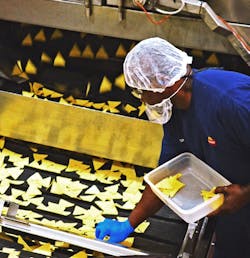Frito-Lay Improves Workplace Ergonomics with Wearable Technology
As the Industrial Internet of Things (IIoT) expands, it’s not just smart instruments, conveyors, and robots that are being outfitted with data-gathering intelligent sensors. Increasingly, they’re finding their way onto workers themselves. Wearable technologies are being put to a variety of uses, including enabling remote assistance via augmented reality (AR) headsets, measuring labor efficiency to develop pay-for-performance frameworks that reward workers for efficiency, and monitoring the postures of employees with the goal of improving workplace ergonomics and reducing injuries.
A recent case study from Frito-Lay demonstrates this latter application. Beginning in the summer of 2020, the company outfitted workers in 34 of its North American manufacturing and distribution centers with Kinetic’s Reflex devices. The devices are belt-mounted wearable sensors that automatically detect when a worker is assuming high-risk postures such as bending, overreaching, or twisting that may lead to repetitive strain injuries while on the job. From here, the actions taken are two-fold. First, workers receive real-time feedback via a gentle vibration which alerts them that they have assumed a high-risk posture, helping them to adjust their behavior. After that, the data is sent to a cloud-based web dashboard that provides management with insights on how to improve workplace ergonomics.
Not only does this help to improve the health of workers by preventing injuries, but it saves Frito-Lay money by reducing worker compensation costs related to repetitive strain and other workplace-related impairments. According to Frito-Lay, the initiative has resulted in a 19% reduction in Occupational Safety and Health Administration (OSHA) recordable injuries, and 67% less work-time lost—a critical improvement amidst continuing labor shortages.
In the past, Frito-Lay sought to reduce the number of high-risk postures workers assume by bringing in athletic trainers to educate them on how to perform physical tasks more safely. However, this approach has been largely ineffective, as the information communicated during these one-time training sessions is seldom retained. Moreover, the company has found that employees have been more willing to make changes to their behavior when they are receiving and acting on data insights themselves, rather than merely taking instructions from supervisors. To further motivate them, the Reflex software sets quantitative benchmarks for workers to pursue and allows them to compete against each other to see who can improve the most.
“We’ve always done all the traditional ergonomic work, but there has been something missing. We weren’t able to tap into that behavioral element to create a sense of ownership in the individual employee and help them behave posturally in a different way,” said Cormac Gilligan, vice president of global environment for health and safety at PepsiCo, Frito-Lay’s parent company.
In addition to helping workers adjust their own postures, the data gathered by the Reflex devices can also be used to redesign the spatial arrangement of facilities, making them easier to navigate for workers. For example, the use of Reflex at Frito-Lay’s Kern plant in California, helped management identify precisely when and where the most high-risk postures were occurring and why they were so difficult to avoid in those locations. By analyzing this data, the company discovered that workstation space limitations during ingredient changeover were forcing employees to twist and bend in a dangerous way. Not only that, but the size and position of a conveyor being used meant that workers had to continuously over-exert themselves to reach items moving along it.
“After receiving an alert, employees stop and think about whether there is something they could do differently. They then initiate conversations with us about why they have to adopt a high-risk posture, and how we could redesign the workspace or the process,” said Gilligan. “So you’ve got culture change happening at the same time as behavior change. That is something we’ve never had before with our ergonomics programs.”
About the Author
David Miller
Former Senior Technical Writer

Leaders relevant to this article:
